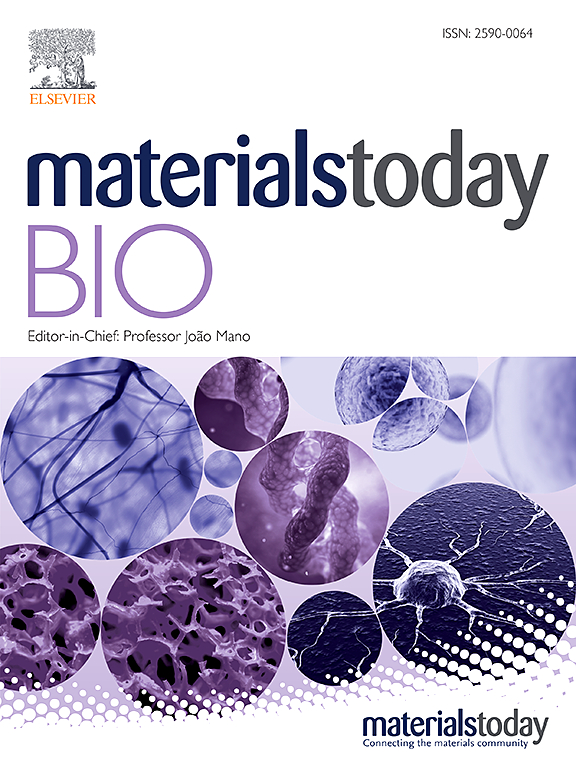Dynamic multistage nanozyme hydrogel reprograms diabetic wound microenvironment: synergistic oxidative stress alleviation and mitochondrial restoration
IF 8.7
1区 医学
Q1 ENGINEERING, BIOMEDICAL
引用次数: 0
Abstract
Chronic diabetic wounds remain a significant clinical challenge due to persistent bacterial infections, oxidative stress, impaired angiogenesis, and mitochondrial dysfunction. Traditional therapies often fail to address these interrelated pathological factors, highlighting the urgent need for innovative solutions. Here, we present a Mn-ZIF@GOx/BC (MZGB) hydrogel system, where Mn-ZIF@GOx (MZG) nanozymes are successfully integrated into a bacterial cellulose (BC) hydrogel via hydrogen bonding and electrostatic interactions. The MZGB hydrogel lowers wound pH by oxidizing excess glucose into gluconic acid. It exhibits strong ROS scavenging capabilities through its superoxide dismutase and catalase-like activities, while simultaneously providing oxygen. By restoring redox homeostasis, it protects mitochondrial function and enhances cellular energy metabolism. By reprogramming macrophages, MZGB creates a favorable immune microenvironment, significantly promoting angiogenesis through paracrine mechanisms. This facilitates cell-to-cell communication, forming a positive feedback loop. Moreover, MZGB demonstrates ROS-independent antibacterial properties. BC hydrogel ensures adhesion and moisture regulation, forming a protective barrier and maintaining an optimal wound environment. This multifunctional hydrogel represents a promising nanotherapeutic approach for efficiently treating diabetic wounds by precisely regulating the wound microenvironment.

动态多级纳米酶水凝胶重编程糖尿病伤口微环境:协同氧化应激缓解和线粒体修复
由于持续的细菌感染、氧化应激、血管生成受损和线粒体功能障碍,慢性糖尿病伤口仍然是一个重大的临床挑战。传统疗法往往无法解决这些相互关联的病理因素,因此迫切需要创新的解决方案。在这里,我们提出了Mn-ZIF@GOx/BC (MZGB)水凝胶体系,其中Mn-ZIF@GOx (MZG)纳米酶通过氢键和静电相互作用成功地整合到细菌纤维素(BC)水凝胶中。MZGB水凝胶通过将过量葡萄糖氧化成葡萄糖酸来降低伤口pH值。它通过其超氧化物歧化酶和过氧化氢酶样活性表现出强大的活性氧清除能力,同时提供氧气。通过恢复氧化还原稳态,保护线粒体功能,增强细胞能量代谢。MZGB通过重编程巨噬细胞,创造良好的免疫微环境,通过旁分泌机制显著促进血管生成。这促进了细胞间的交流,形成了一个正反馈循环。此外,MZGB具有不依赖ros的抗菌性能。BC水凝胶确保附着力和水分调节,形成保护屏障,保持最佳的伤口环境。这种多功能水凝胶代表了一种有前途的纳米治疗方法,可以通过精确调节伤口微环境来有效治疗糖尿病伤口。
本文章由计算机程序翻译,如有差异,请以英文原文为准。
求助全文
约1分钟内获得全文
求助全文
来源期刊

Materials Today Bio
Multiple-
CiteScore
8.30
自引率
4.90%
发文量
303
审稿时长
30 days
期刊介绍:
Materials Today Bio is a multidisciplinary journal that specializes in the intersection between biology and materials science, chemistry, physics, engineering, and medicine. It covers various aspects such as the design and assembly of new structures, their interaction with biological systems, functionalization, bioimaging, therapies, and diagnostics in healthcare. The journal aims to showcase the most significant advancements and discoveries in this field. As part of the Materials Today family, Materials Today Bio provides rigorous peer review, quick decision-making, and high visibility for authors. It is indexed in Scopus, PubMed Central, Emerging Sources, Citation Index (ESCI), and Directory of Open Access Journals (DOAJ).
 求助内容:
求助内容: 应助结果提醒方式:
应助结果提醒方式:


